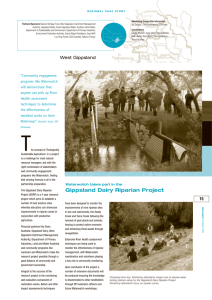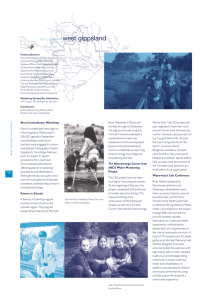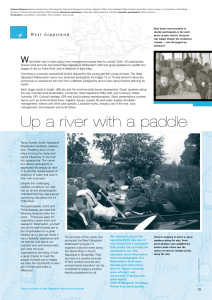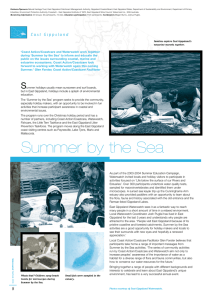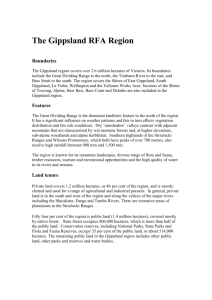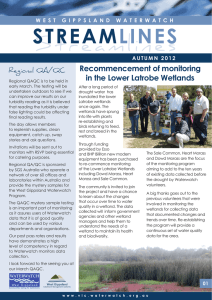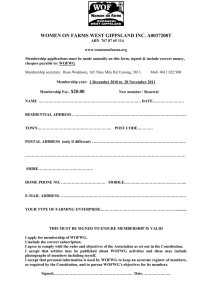natural ‘asset’ 2007/08 East Gippsland Making the most of a
advertisement
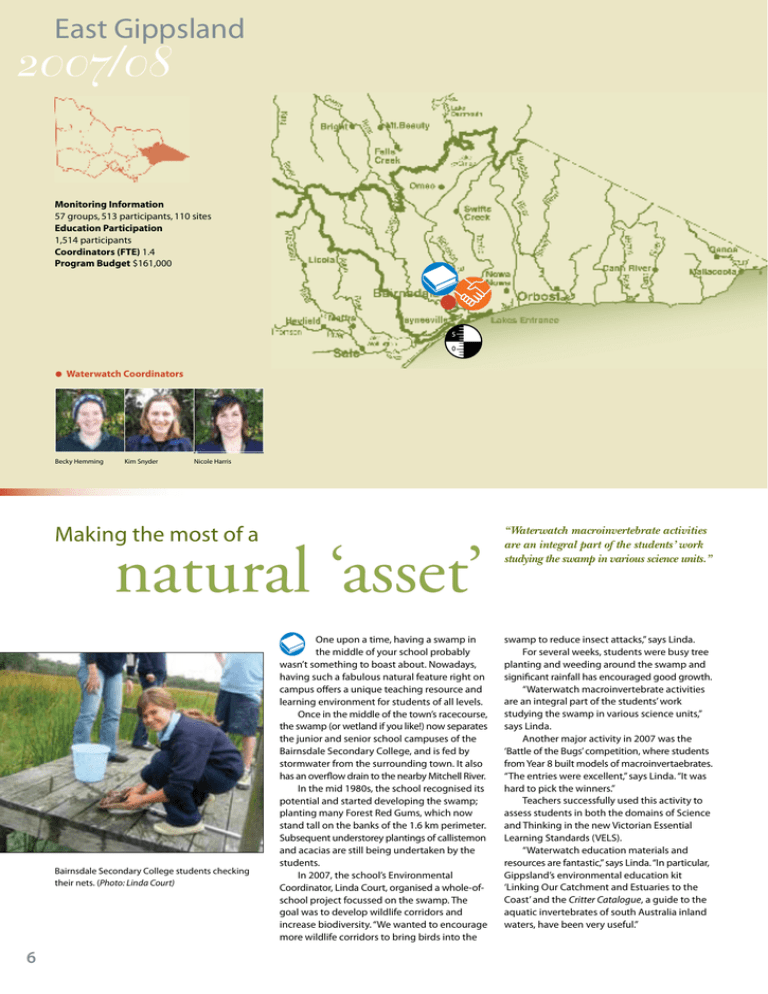
East Gippsland 2007/08 Monitoring Information 57 groups, 513 participants, 110 sites Education Participation 1,514 participants Coordinators (FTE) 1.4 Program Budget $161,000 • Waterwatch Coordinators Becky Hemming Kim Snyder Nicole Harris Making the most of a natural ‘asset’ Bairnsdale Secondary College students checking their nets. (Photo: Linda Court) 6 One upon a time, having a swamp in the middle of your school probably wasn’t something to boast about. Nowadays, having such a fabulous natural feature right on campus offers a unique teaching resource and learning environment for students of all levels. Once in the middle of the town’s racecourse, the swamp (or wetland if you like!) now separates the junior and senior school campuses of the Bairnsdale Secondary College, and is fed by stormwater from the surrounding town. It also has an overflow drain to the nearby Mitchell River. In the mid 1980s, the school recognised its potential and started developing the swamp; planting many Forest Red Gums, which now stand tall on the banks of the 1.6 km perimeter. Subsequent understorey plantings of callistemon and acacias are still being undertaken by the students. In 2007, the school’s Environmental Coordinator, Linda Court, organised a whole-ofschool project focussed on the swamp. The goal was to develop wildlife corridors and increase biodiversity. “We wanted to encourage more wildlife corridors to bring birds into the “Waterwatch macroinvertebrate activities are an integral part of the students’ work studying the swamp in various science units.” swamp to reduce insect attacks,” says Linda. For several weeks, students were busy tree planting and weeding around the swamp and significant rainfall has encouraged good growth. “Waterwatch macroinvertebrate activities are an integral part of the students’ work studying the swamp in various science units,” says Linda. Another major activity in 2007 was the ‘Battle of the Bugs’ competition, where students from Year 8 built models of macroinvertaebrates. “The entries were excellent,” says Linda. “It was hard to pick the winners.” Teachers successfully used this activity to assess students in both the domains of Science and Thinking in the new Victorian Essential Learning Standards (VELS). “Waterwatch education materials and resources are fantastic,” says Linda. “In particular, Gippsland’s environmental education kit ‘Linking Our Catchment and Estuaries to the Coast’ and the Critter Catalogue, a guide to the aquatic invertebrates of south Australia inland waters, have been very useful.” Caring for the carers Thousands of volunteer ‘carers’ across Victoria give up free time to look after our natural resources. Waterwatch East Gippsland, together with Fishcare, Landcare, Coastcare and the East Gippsland Catchment Management Authority, have worked out a way to give back to their ‘carers’. The annual ‘Bringing the Care Groups Together’ day is organised to show appreciation for the efforts of care groups, to increase their knowledge and to provide an opportunity to learn from each other. The concept of Care Day came about in 2003 with the aim of “giving something back to volunteers”, says Tonia Stokes, East Gippsland Fishcare Facilitator. “We wanted to give them a day that was all about them – to help build up their knowledge, training and give volunteers and staff a chance to network.” The 2007 event focused on natural disasters and their impact on the East Gippsland catchment – topical in a year of drought, fire and floods. More than 60 volunteers from 18 different environment care organisations signed up to see the effects first hand. Scientific experts set the scene at morning seminars that were followed up in the afternoon by a field trip to two sites in the Nicholson River catchment. The first site, at Waterholes Guest House, displayed the impact of drought, fire and flood on the upper reaches of the Nicholson River. After 30 years of living at the Waterholes, owners Kaye and Bob Munroe had learnt not to ‘impose’ on the environment when revegetating the riverbanks. Rather they have taken a ‘gently does it approach’, which has paid off. There was very little erosion after the fire and flood, vegetation has sprouted, and it is all ‘coming together’. The second site at Sarsfield offered the opportunity to view habitat and protection works, learn about some of the native fish studies and water quality issues. Feedback from participants was very From A Great Egret, snapped by long-time Waterwatch monitor and enthusiastic bird photographer, Ron Mackenzie. (Photo: Ron Mackenzie) “Keen observers can provide valuable information on the changes occurring in their local environments which might otherwise be missed!” East Gippsland environment care group volunteers see first-hand the effects of drought, fire and floods. positive. In response to the question “What was most worthwhile about the event?”, one participant remarked, “the ability for various groups to network and gain information on a number of aspects, not just their prime interest” and another said “mixing with staff and volunteers from agencies and care groups”. The 2008 Care Day has ‘inspiration’ as its topic – so watch out, there’s lots of caring to come yet! engineer to observer Ron Mackenzie has been living on tranquil Raymond Island on the Gippsland Lakes for more than 20 years. The Lakes are one of Victoria’s 11 Ramsar wetland sites of international importance, requiring conservation and protection. Ron helps with this protection through the regular water quality monitoring he has been doing since 1995 at Macleod’s Morass and McMillan Strait. After a career in engineering as a senior manager – meaning lots of time in meetings and on committees – Ron wanted to do something completely different in his retirement. Thanks to his keen interest in birds, becoming a monitor was an easy decision. Ron’s background hasn’t been left behind entirely. His engineering eye has noticed many changes in the management of the Morass, including upgrading of the sewerage plant process, installation of a large fine screen in the storm water discharge pipe to keep debris out of the Morass and installation of new ‘outlet’ gates, to improve flood discharge and to prevent ingress of salty water from the Mitchell River during periods of low flow or drought. Ron says that heavy rains after the major 2006/07 alpine fires flushed enormous quantities of soil and ash into the rivers and lakes. This pollution resulted in the need for extra plants to treat the local water supplies, and it contributed to the lake’s recent algal blooms. Ron has turned his efforts to collecting water quality samples to help inform management and protection of the Lakes. One of his sites is nearly on the doorstep of his home on the McMillan Strait, between Raymond Island and Paynesville. The other is at nearby Macleod Morass – a 250 hectare, deep freshwater marsh/wetland that teems with birds and was originally the bed of the Mitchell River. Ron is a keen photographer, so the Morass is a treasure trove of photo opportunities. Partners and Sponsors of the East Gippsland Waterwatch Program Natural Heritage Trust, East Gippsland Catchment Management Authority, SGS Environmental Services, Department of Sustainability and Environment, East Gippsland Shire, East Gippsland Water, Fishcare. 7

